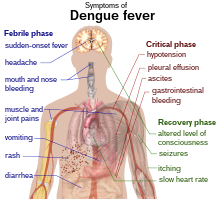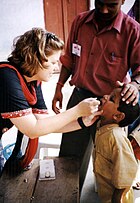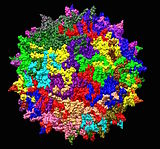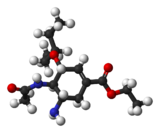Portal:Viruses
The Viruses Portal
Welcome!

Viruses are small infectious agents that can replicate only inside the living cells of an organism. Viruses infect all forms of life, including animals, plants, fungi, bacteria and archaea. They are found in almost every ecosystem on Earth and are the most abundant type of biological entity, with millions of different types, although only about 6,000 viruses have been described in detail. Some viruses cause disease in humans, and others are responsible for economically important diseases of livestock and crops.
Virus particles (known as virions) consist of genetic material, which can be either DNA or RNA, wrapped in a protein coat called the capsid; some viruses also have an outer lipid envelope. The capsid can take simple helical or icosahedral forms, or more complex structures. The average virus is about 1/100 the size of the average bacterium, and most are too small to be seen directly with an optical microscope.
The origins of viruses are unclear: some may have evolved from plasmids, others from bacteria. Viruses are sometimes considered to be a life form, because they carry genetic material, reproduce and evolve through natural selection. However they lack key characteristics (such as cell structure) that are generally considered necessary to count as life. Because they possess some but not all such qualities, viruses have been described as "organisms at the edge of life".
Selected disease
Dengue fever, or breakbone fever, is an infectious tropical disease caused by the dengue virus. Symptoms include fever, headache, muscle and joint pains, and a characteristic skin rash that is similar to measles. Rarely, the disease develops into the life-threatening dengue haemorrhagic fever, resulting in bleeding, low levels of blood platelets and blood plasma leakage, or into dengue shock syndrome, where dangerously low blood pressure occurs.
Dengue is transmitted by several species of Aedes mosquito, mainly A. aegypti. First described in 1779, the incidence of dengue fever has increased dramatically since the Second World War, with around 390 million people infected each year, of whom about 40,000 die. The virus is endemic in more than 120 countries, mainly in Southeast Asia, South Asia and South America. Infection with one of the five viral types usually gives lifelong immunity to that type but only short-term immunity to the others, and subsequent infection with a different type increases the risk of severe complications. Treatment of acute dengue is supportive, using oral or intravenous fluids for mild or moderate disease; blood transfusion may be required in more severe cases. A vaccine against dengue fever is available. Reducing mosquito habitats and limiting exposure to bites are the other main methods of control.
Selected image
Biosafety level 3 equipment is used for research with viruses such as influenza that can cause serious disease but for which treatment is available. The biosafety cabinet uses HEPA filters to filter viruses out of the air. This researcher is examining reconstructed 1918 pandemic influenza virus, or "Spanish flu".
Credit: CDC (2005)
In the news
26 February: In the ongoing pandemic of severe acute respiratory syndrome coronavirus 2 (SARS-CoV-2), more than 110 million confirmed cases, including 2.5 million deaths, have been documented globally since the outbreak began in December 2019. WHO
18 February: Seven asymptomatic cases of avian influenza A subtype H5N8, the first documented H5N8 cases in humans, are reported in Astrakhan Oblast, Russia, after more than 100,0000 hens died on a poultry farm in December. WHO
14 February: Seven cases of Ebola virus disease are reported in Gouécké, south-east Guinea. WHO
7 February: A case of Ebola virus disease is detected in North Kivu Province of the Democratic Republic of the Congo. WHO
4 February: An outbreak of Rift Valley fever is ongoing in Kenya, with 32 human cases, including 11 deaths, since the outbreak started in November. WHO
21 November: The US Food and Drug Administration (FDA) gives emergency-use authorisation to casirivimab/imdevimab, a combination monoclonal antibody (mAb) therapy for non-hospitalised people twelve years and over with mild-to-moderate COVID-19, after granting emergency-use authorisation to the single mAb bamlanivimab earlier in the month. FDA 1, 2
18 November: The outbreak of Ebola virus disease in Équateur Province, Democratic Republic of the Congo, which started in June, has been declared over; a total of 130 cases were recorded, with 55 deaths. UN
Selected article
Vaccination or immunisation is the administration of immunogenic material (a vaccine) to stimulate an individual's immune system to develop adaptive immunity to a virus or other pathogen, and so develop protection against an infectious disease. The active agent of a vaccine may be intact but inactivated or weakened forms of the pathogen, or purified highly immunogenic components, such as viral envelope proteins. Smallpox was the first disease for which a vaccine was produced, by Edward Jenner in 1796.
Vaccination is the most effective method of preventing infectious diseases and can also ameliorate the symptoms of infection. When a sufficiently high proportion of a population has been vaccinated, herd immunity results. Widespread immunity due to mass vaccination is largely responsible for the worldwide eradication of smallpox and the elimination of diseases such as polio from much of the world. Since their inception, vaccination efforts have met with objections on scientific, ethical, political, medical safety and religious grounds, and the World Health Organization considers vaccine hesitancy an important threat to global health.
Selected outbreak
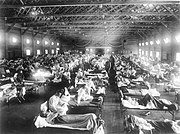
The 1918–20 influenza pandemic, the first of the two involving H1N1 influenza virus, was unusually deadly. It infected 500 million people across the entire globe, with a death toll of 50–100 million (3–5% of the world's population), making it one of the deadliest natural disasters of human history. It has also been implicated in the outbreak of encephalitis lethargica in the 1920s. Despite the nickname "Spanish flu", the pandemic's geographic origin is unknown.
Most influenza outbreaks disproportionately kill young, elderly or already weakened patients; in contrast this predominantly killed healthy young adults. Contemporary medical reports suggest that malnourishment, overcrowded medical facilities and poor hygiene promoted fatal bacterial pneumonia. Some research suggests that the virus might have killed through a cytokine storm, an overreaction of the body's immune system. This would mean the strong immune reactions of young adults resulted in a more severe disease than the weaker immune systems of children and older adults.
Selected quotation
| “ | ...in a flash I had understood: what caused my clear spots was, in fact, an invisible microbe, a filterable virus, but a virus parasitic on bacteria. | ” |
—Félix d'Herelle on the discovery of bacteriophages
Recommended articles
Viruses & Subviral agents: bat virome • elephant endotheliotropic herpesvirus • HIV • introduction to viruses![]() • Playa de Oro virus • poliovirus • prion • rotavirus
• Playa de Oro virus • poliovirus • prion • rotavirus![]() • virus
• virus![]()
Diseases: colony collapse disorder • common cold • croup • dengue fever![]() • gastroenteritis • Guillain–Barré syndrome • hepatitis B • hepatitis C • hepatitis E • herpes simplex • HIV/AIDS • influenza
• gastroenteritis • Guillain–Barré syndrome • hepatitis B • hepatitis C • hepatitis E • herpes simplex • HIV/AIDS • influenza![]() • meningitis
• meningitis![]() • myxomatosis • polio
• myxomatosis • polio![]() • pneumonia • shingles • smallpox
• pneumonia • shingles • smallpox
Epidemiology & Interventions: 2007 Bernard Matthews H5N1 outbreak • Coalition for Epidemic Preparedness Innovations • Disease X • 2009 flu pandemic • HIV/AIDS in Malawi • polio vaccine • Spanish flu • West African Ebola virus epidemic
Virus–Host interactions: antibody • host • immune system![]() • parasitism • RNA interference
• parasitism • RNA interference![]()
Methodology: metagenomics
Social & Media: And the Band Played On • Contagion • "Flu Season" • Frank's Cock![]() • Race Against Time: Searching for Hope in AIDS-Ravaged Africa
• Race Against Time: Searching for Hope in AIDS-Ravaged Africa![]() • social history of viruses
• social history of viruses![]() • "Steve Burdick" • "The Time Is Now" • "What Lies Below"
• "Steve Burdick" • "The Time Is Now" • "What Lies Below"
People: Brownie Mary • Macfarlane Burnet![]() • Bobbi Campbell • Aniru Conteh • people with hepatitis C
• Bobbi Campbell • Aniru Conteh • people with hepatitis C![]() • HIV-positive people
• HIV-positive people![]() • Bette Korber • Henrietta Lacks • Linda Laubenstein • Barbara McClintock
• Bette Korber • Henrietta Lacks • Linda Laubenstein • Barbara McClintock![]() • poliomyelitis survivors
• poliomyelitis survivors![]() • Joseph Sonnabend • Eli Todd • Ryan White
• Joseph Sonnabend • Eli Todd • Ryan White![]()
Selected virus
Adeno-associated viruses (AAVs) are two small DNA viruses in the Dependoparvovirus genus of the Parvoviridae family. They cannot complete their lytic replication cycle without a helper virus, which include adenoviruses, herpesviruses and vaccinia. In the absence of the helper, AAVs can integrate into the host genome at a specific site on human chromosome 19, or persist as an episome. The 20 nm icosahedral capsid lacks an envelope, and contains a single-stranded DNA genome of around 4.7 kb. AAVs infect humans and some other primates without causing disease. They generate only a mild immune response, including neutralising antibodies. The best-studied of the 11 serotypes, AAV-2, infects nerve cells, liver cells, skeletal muscle and vascular smooth muscle, using heparan sulphate proteoglycan as its primary receptor.
Its low pathogenicity makes AAV an attractive basis for viral vectors for gene therapy. Alipogene tiparvovec to treat lipoprotein lipase deficiency was the first gene therapy to be licensed, but was later withdrawn. Promising results have been obtained in early clinical trials with AAV-based gene therapy in haemophilia, congestive heart failure, spinal muscular atrophy, Parkinson's disease and the rare eye disease Leber congenital amaurosis.
Did you know?
- ...that the genetically modified plum C5 is the only Prunus species resistant to the devastating plant disease plum pox?
- ...that research by Dorothy M. Horstmann and Robert W. McCollum at Yale University showed that the poliovirus reaches the brain by way of the blood, leading to the development of the polio vaccine in the early 1950s?
- ...that sea sponge aquaculture has the potential to generate novel anti-inflammatory and antiviral drugs?
- ...that in response to the Hong Kong government refusing to close its border with mainland China to contain COVID-19, Winnie Yu organized a labour strike among hospital workers in February 2020?
- ...that CCR5 receptor antagonists are drugs that inhibit the entry of HIV into cells of the immune system?
Selected biography
Françoise Barré-Sinoussi (born 30 July 1947) is a French virologist, known for being one of the researchers who discovered HIV.
Barré-Sinoussi researched retroviruses in Luc Montagnier's group at the Institut Pasteur in Paris. In 1982, she and her co-workers started to analyse samples from people with a new disease, then referred to as "gay-related immune deficiency". They found a novel retrovirus in lymph node tissue, which they called "lymphadenopathy-associated virus". Their results were published simultaneously with those of Robert Gallo's group in the USA, who had independently discovered the virus under the name "human T-lymphotropic virus type III". The virus, renamed "human immunodeficiency virus", was later shown to cause AIDS. Barré-Sinoussi continued to research HIV until her retirement in 2015, studying how the virus is transmitted from mother to child, the immune response to HIV, and how a small proportion of infected individuals, termed "long-term nonprogressors", can limit HIV replication without treatment. In 2008, she was awarded the Nobel Prize, with Montagnier, for the discovery of HIV.
In this month
May 1955: First issue of Virology; first English-language journal dedicated to virology
4 May 1984: HTLV-III, later HIV, identified as the cause of AIDS by Robert Gallo and coworkers
5 May 1939: First electron micrographs of tobacco mosaic virus taken by Helmut Ruska and coworkers
5 May 1983: Structure of influenza neuraminidase solved by Jose Varghese, Graeme Laver and Peter Colman
8 May 1980: WHO announced formally the global eradication of smallpox
11 May 1978: SV40 sequenced by Walter Fiers and coworkers
12 May 1972: Gene for bacteriophage MS2 coat protein is sequenced by Walter Fiers and coworkers, the first gene to be completely sequenced
13 May 2011: Boceprevir approved for the treatment of chronic hepatitis C virus (HCV) infection, the first direct-acting antiviral for HCV
14 May 1796: Edward Jenner inoculated James Phipps (pictured) with cowpox
15/16 May 1969: Death of Robert Rayford, the earliest confirmed case of AIDS outside Africa
18 May 1998: First World AIDS Vaccine Day
20 May 1983: Isolation of the retrovirus LAV, later HIV, by Luc Montagnier, Françoise Barré-Sinoussi and coworkers
23 May 2011: Telaprevir approved for the treatment of chronic HCV infection
25 May 2011: WHO declared rinderpest eradicated
31 May 1937: First results in humans from the 17D vaccine for yellow fever published by Max Theiler and Hugh H. Smith
Selected intervention
Oseltamivir (also Tamiflu) is an oral antiviral drug against influenza (flu). It was the second inhibitor of the viral neuraminidase to be developed, after zanamivir, and the first to be taken as an oral tablet. It was originally synthesised from shikimic acid extracted from the star anise plant. Oseltamivir is a prodrug that requires metabolism in the liver to the active form, oseltamivir carboxylate. This binds at the active site of the neuraminidase enzyme, preventing it from cleaving sialic acid to release the virus particle from the host cell. Oseltamivir can reduce the duration of influenza symptoms by 0.5–1 days. Debate is ongoing about whether it also reduces the risk of complications, such as pneumonia. Nausea and vomiting are the main adverse events. Resistance to oseltamivir has been observed in some strains of influenza virus, especially H1N1 strains.
Subcategories
Subcategories of virology:
Topics
Things to do
- Comment on what you like and dislike about this portal
- Join the Viruses WikiProject
- Tag articles on viruses and virology with the project banner by adding {{WikiProject Viruses}} to the talk page
- Assess unassessed articles against the project standards
- Create requested pages: red-linked viruses | red-linked virus genera
- Expand a virus stub into a full article, adding images, citations, references and taxoboxes, following the project guidelines
- Create a new article (or expand an old one 5-fold) and nominate it for the main page Did You Know? section
- Improve a B-class article and nominate it for Good Article
 or Featured Article
or Featured Article status
status - Suggest articles, pictures, interesting facts, events and news to be featured here on the portal
WikiProjects & Portals
 WikiProject Viruses
Related WikiProjects
WikiProject Viruses
Related WikiProjects
Medicine • Microbiology • Molecular & Cellular Biology • Veterinary Medicine
Related PortalsAssociated Wikimedia
The following Wikimedia Foundation sister projects provide more on this subject:
-
Commons
Free media repository -
Wikibooks
Free textbooks and manuals -
Wikidata
Free knowledge base -
Wikinews
Free-content news -
Wikiquote
Collection of quotations -
Wikisource
Free-content library -
Wikispecies
Directory of species -
Wikiversity
Free learning tools -
Wiktionary
Dictionary and thesaurus

